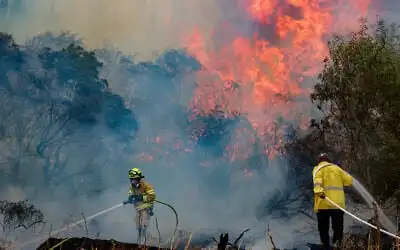Rainfall affected most parts of Nepal on Wednesday night and some areas on Thursday, which improved air quality.
This rainfall provided much-needed relief from the hazardous levels of air pollution. The widespread rain also helped extinguish many of the wildfires that had been burning across the country for weeks.
Rain brings relief as air pollution and wildfires decline
According to the Meteorological Forecasting Division, a low-pressure system over the Bay of Bengal and moisture from the Arabian Sea combined to produce the rain. Nepal’s extreme pollution levels and wildfires were lessened because of this weather pattern.
“Compared to previous days, both pollution levels and wildfire incidents have decreased ,” said meteorologist Hari Prasad Dahal. Rain hit most of the country on Wednesday night, and some regions also received rain on Thursday.
According to experts, this is the worst air pollution Nepal has seen since late March. Haze and pollution used to last the nation around a week, but this year they have persisted for more than two weeks, with visibility dipping to less than eight kilometers.
Nepal’s air quality improves but power outages and floods continue
Wildfires have been raging throughout Nepal for a few weeks, even in national parks like Bardiya and Chitwan. Rainfall helped reduce the number of wildfires, with only nine flames reported on Wednesday and Thursday.
Even with the rain, the air quality in Kathmandu, which was once the most polluted city in the world, remained poor due to high pollution levels.
For more than two months, there have been numerous days of hazardous air due to pollution, primarily from microscopic particles known as PM2.5. With more rain predicted through Sunday, meteorologists say the air quality will improve.
But the rain also brought about a number of problems, including flooding and landslides, as well as power disruptions brought on by high winds. While the rain helped reduce wildfires and pollution, it also caused travel disruptions and damage in some areas.


 Why Nepal’s MaPaSe Drink-Driving Tests Called Unscientific
Why Nepal’s MaPaSe Drink-Driving Tests Called Unscientific  Apple Shifts Device Production to India and Vietnam
Apple Shifts Device Production to India and Vietnam  Why Barcelona vs. Inter Was a Classic
Why Barcelona vs. Inter Was a Classic  Fan Falls from Clemente Wall During Pirates-Cubs Game
Fan Falls from Clemente Wall During Pirates-Cubs Game  Massive Wildfire Rages Near Jerusalem
Massive Wildfire Rages Near Jerusalem  Angelina Jolie Calls Gaza a “Mass Grave” for Palestinians
Angelina Jolie Calls Gaza a “Mass Grave” for Palestinians
1 Comment